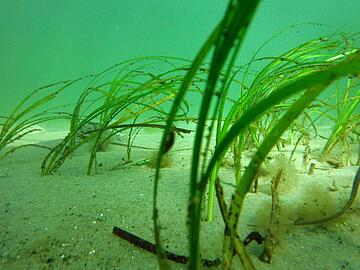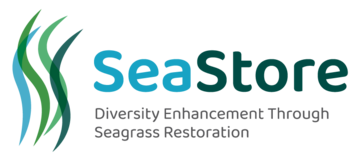Project
SeaStore – Diversity enhancement through seagrass restoration
Start of Project: 01.11.2020 — End of Project: 30.10.2023
Seagrass beds provide important ecological functions and ecosystem services (ES) for humans. In particular, they promote biodiversity, stabilize the sediment and support the binding of nutrients. As climate change continues, the ability of seagrass to sequester carbon for long periods of time has become a focus of public interest. The successful establishment of seagrass can lead to an increase in carbon sequestration in coastal ecosystems and is considered a so-called Natural Climate Solution. These offer the opportunity to combine the pursuit of climate protection goals with global sustainability goals (SDGs).
Failures in previous reintroduction measures for common seaweed indicate that its ecological niche is still poorly understood. The joint project creates the scientific basis for a robust and scientifically sound restoration of seagrass beds in the German Baltic Sea region. The success of the restoration efforts will also be evaluated with regard to the provision of the most important ES. The sub-project of the Kiel Institute concentrates especially on the analysis of costs and benefits as well as the public perception and acceptance of seagrass restoration. Furthermore, the Kiel Institute coordinates and supports the communication with the general public and the communication process with representatives from administration and politics.

The sub-project includes as a first component an investigation of the public perception and acceptance of seagrass restoration projects. In particular against the background of the progressive climate change, natural methods are sought with which CO2 can be bound from the atmosphere. The planting of seagrass offers such a possibility, but it is unclear how such an active intervention in nature is perceived by the population and whether it is accepted. However, lack of acceptance could be an obstacle to the implementation of seagrass restoration projects. Therefore, acceptance and perception will be analyzed in this sub-project with the help of nationwide, representative online surveys.
The second component of the sub-project is the economic evaluation of the costs and benefits of seagrass restoration activities. One of the goals is a cost-effectiveness analysis, which will show which settlement methods are the best to achieve the settlement goals. Furthermore, an economic evaluation of the most important ES will be carried out, with a focus on carbon sequestration. As a third component, the Kiel Institute will accompany the communication process with stakeholders. This includes co-design and close coordination of the research work with representatives from administration and politics. The results on the acceptance as well as on the costs and benefits of seagrass restoration will also be incorporated into the decision support tool that is being developed within the framework of the joint project.










